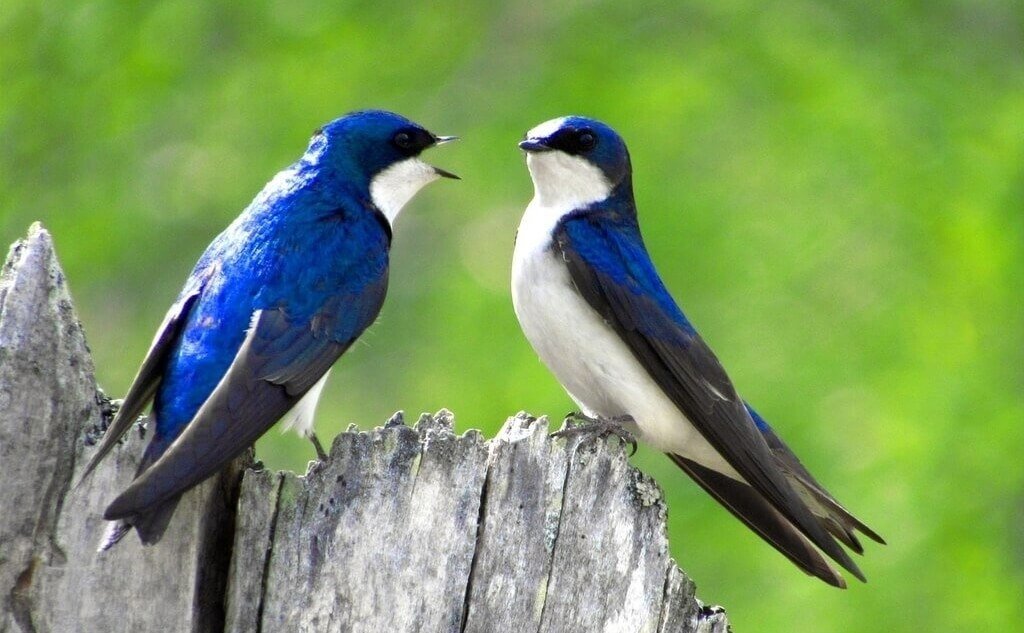
Wondering how to attract swallows to your yard? This ultimate guide covers everything you need to know about attracting these graceful birds, from creating the right habitat to providing nesting opportunities and food sources.
Table of Contents
Key Takeaways
- Create a welcoming habitat: Provide suitable nesting sites, such as swallow houses or platforms, and ensure a nearby water source for drinking and bathing.
- Open up your menu: Offer a diverse array of flying insects, including mosquitoes, flies, and beetles, to entice swallows with a delectable buffet and don’t forget mealworms.
- Keep it tidy: Maintain a clean and clutter-free yard to attract swallows, as they prefer open spaces and dislike crowded or messy environments.
- Embrace water features: Installing a birdbath or small pond not only provides a drinking spot but also attracts insects, which are a vital food source for swallows.
- Keep predators at bay: Implement measures like predator guards and deterrents to protect swallow nests from squirrels, cats, and other threats.
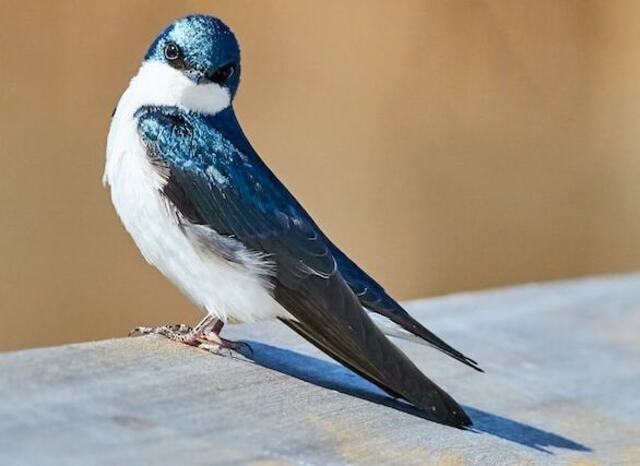
Identifying Swallows
When it comes to identifying swallows, there are several key features and behaviors to look for. Here are some tips on how to identify swallows:
- Size and Shape: Swallows are generally small to medium-sized birds with slender bodies, long pointed wings, and forked tails. They have a streamlined shape, ideal for swift and agile flight.
- Flight Pattern: Swallows are known for their acrobatic flight. They are highly maneuverable, performing graceful twists, turns, and aerial displays. They often fly low over open areas, swooping and darting to catch insects on the wing.
- Plumage: Swallows typically have sleek and glossy feathers. The coloration varies depending on the species. Common colors include metallic blue, green, or purple on the upperparts, and lighter shades on the underparts.
- Facial Features: Swallows have relatively large eyes and short, pointed bills. Some species have distinct facial markings, such as dark eye patches or contrasting throat colors.
- Tail Shape: Pay attention to the shape of the swallow’s tail. Most swallows have deeply forked tails, where the outer tail feathers are longer than the central ones. However, a few species, like the Purple Martin, have square or slightly notched tails.
- Habitat: Swallows have specific habitat preferences. Different species can be found near bodies of water, such as lakes, rivers, wetlands, or open fields. Observing their preferred habitats can provide additional clues for identification.
- Vocalizations: Swallows produce a variety of calls and chirps. Listening to their vocalizations can assist in identifying the species, as different swallows have distinct sounds.
- Range and Season: Consider the location and time of year. Certain swallow species have specific breeding ranges and migration patterns, which can help narrow down the possibilities.
It’s important to note that there are multiple species of swallows, and identification can sometimes be challenging due to similar appearances.
Consulting a field guide, birding resources, or experienced birders can be helpful in confirming the identification of specific swallow species.
Distribution Range
Swallows have expanded their range significantly over the past two decades, now commonly found across the eastern and Midwestern regions of the United States.
This includes states such as Illinois, Indiana, Iowa, Kansas, Missouri, Nebraska, North Dakota, South Dakota, Ohio, Tennessee, Virginia, West Virginia, Wisconsin, and Wyoming.
However, their presence in Canada has declined, and they are now becoming increasingly scarce in the country.
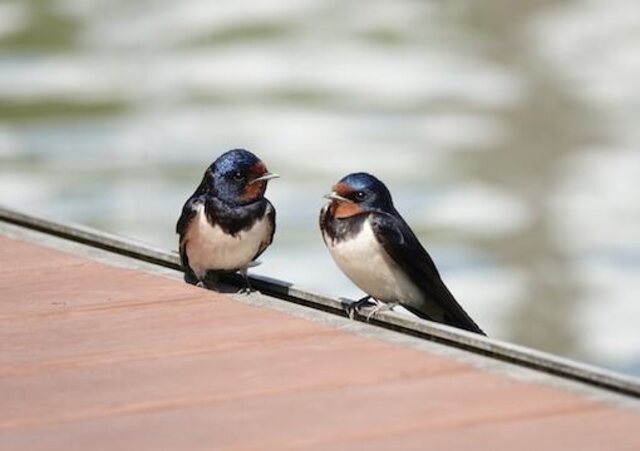
Swallows Species in North America
Discover the array of swallow species that grace the skies of North America, each with its own distinct habitat preferences and dietary habits.
From the agile Barn Swallow to the cavity-nesting Tree Swallow, explore the fascinating diversity of these avian wonders.
| Species | Habitat | Diet | Range |
|---|---|---|---|
| Tree Swallow | Wetlands, open areas | Insects, berries, seeds | Throughout North America |
| Violet-green Swallow | Forest edges, open woodlands | Insects, aerial plankton, berries | Western United States, Canada |
| Barn Swallow | Open fields, farms, urban areas | Insects, flies, beetles | Throughout North America |
| Cliff Swallow | Cliffs, rocky areas, man-made structures | Insects, flies, ants | Western United States, Canada, Mexico |
| Northern Rough-winged | Riverbanks, cliffs, sandy shores | Insects, spiders | Throughout North America |
| Bank Swallow | Riverbanks, sandy areas | Insects, flies | Throughout North America |
| Cave Swallow | Caves, cliffs, buildings | Insects, beetles | Southern United States, Mexico |
| Purple Martin | Open areas with large trees or man-made structures | Insects, aerial prey, berries | Throughout North America |
Best Months To Spot Them
Swallows are migratory birds that make their way to the United States from South America starting in late April or early May.
During this time, they embark on their annual journey northward, seeking suitable nesting grounds and abundant insect food sources.
The arrival of swallows marks the beginning of their breeding season, and it’s an excellent opportunity to spot these small, insect-eating birds in various locations.
These agile creatures have a remarkable adaptability to human environments and can be observed nesting under roofs, eaves, bridges, and even inside buildings.
They seek out structures that offer protection and places to construct their intricate mud nests.
The best months to spot swallows in the United States are generally from late spring to summer, extending through June, July, and into August.
This period coincides with their breeding season and when they are actively raising their young.
During this time, swallows are highly visible as they tirelessly forage for insects, performing their acrobatic flights over fields, wetlands, and bodies of water.
It’s worth noting that the exact timing of swallow sightings may vary depending on the specific geographical region and climate.
Factors such as local temperatures and availability of food sources can influence their arrival and departure dates.
Consulting local birding resources or contacting birding organizations in your area can provide more precise information on the best times and locations to spot swallows in your region.
Keep in mind that observing swallows can be a delightful and rewarding experience, but it’s important to respect their nesting sites and avoid any disturbance that may interfere with their breeding success.
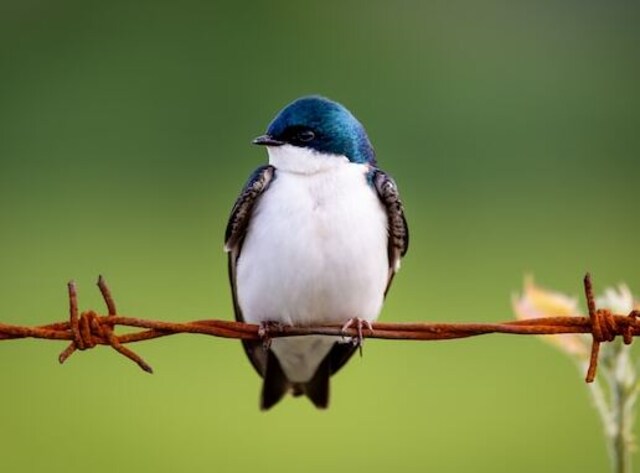
How to Attract Swallows
Discover tried-and-true techniques to create an irresistible environment for swallows in your yard. From enticing nesting sites to enticing menus, these tips will have you welcoming these delightful birds with open wings.
Creating the Ideal Nesting Environment
If you want to attract swallows to your yard, it’s crucial to create the ideal nesting environment. Swallows are cavity nesters, so providing suitable nesting sites is essential.
One way to do this is by installing nesting boxes specifically designed for swallows.
These boxes should be placed in open areas, preferably near a water source and away from trees or other structures that may provide easy access for predators.
It’s important to position the boxes at a height of at least six feet, facing towards an open space.
Additionally, swallows prefer nesting materials such as feathers, dried grass, and mud. You can encourage them to build their nests by providing these materials nearby.
By creating the perfect nesting environment, you significantly increase your chances of attracting swallows to your yard.
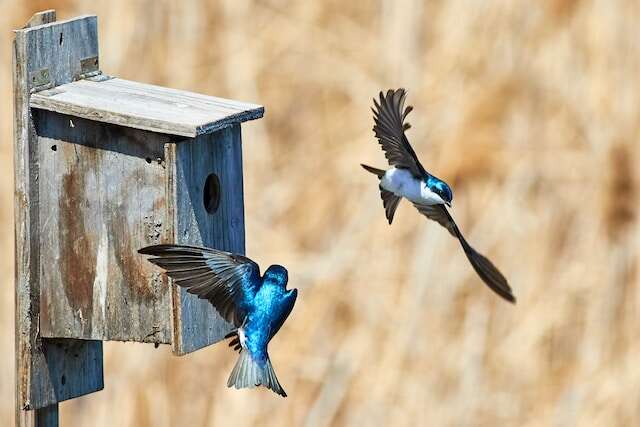
Providing the Right Food Sources
To entice these graceful birds to visit, make sure you are offering the proper nourishment in your outdoor space.
Swallows are insectivores, so providing a variety of insects will attract them to your yard. One way to do this is by planting native plants that attract insects like butterflies and bees.
These plants will not only provide a food source for swallows, but also create a beautiful and natural environment.
Additionally, you can install bird feeders specifically designed for swallows and fill them with mealworms or other small insects.
For your convenience, the products mention below, can be easily purchased on Amazon.
- Bird feeders should be placed at least six feet off the ground, and should include a wide variety of insects and berry blends, such as the Wild Delight Bugs N’ Berries.
- Offer mealworms on a platform tray.
- Offer insect suet with a suet feeder.
It’s important to regularly clean and refill the feeders to ensure a fresh and abundant food supply. By providing the right food sources, you can create a welcoming habitat for swallows in your yard.
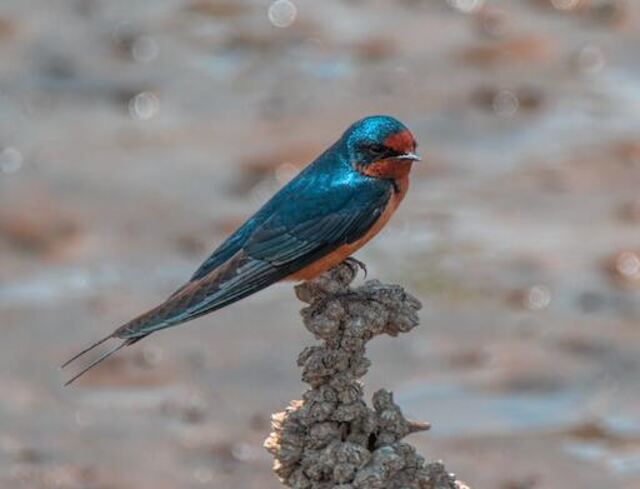
Offering Water and Bathing Areas
Creating a peaceful oasis with a shallow birdbath like this one from Amazon or a gently bubbling fountain will provide swallows with a refreshing spot to drink and bathe.
Swallows are attracted to water sources, especially those that mimic their natural habitat. Place your birdbath near a fence or trellis, so they can have an easy escape route from predators.
The birdbath should be shallow, no more than two inches deep, to allow the swallows to wade in and splash around.
Adding a few stones or pebbles to the bottom of the birdbath will provide perches for the swallows to rest on while they drink or groom their feathers.
It is important to keep the birdbath clean and filled with fresh water, as swallows are attracted to clean water sources.
Additionally, providing a misting system or a sprinkler nearby will create a dynamic water feature that swallows love to fly through, enhancing their bathing experience.
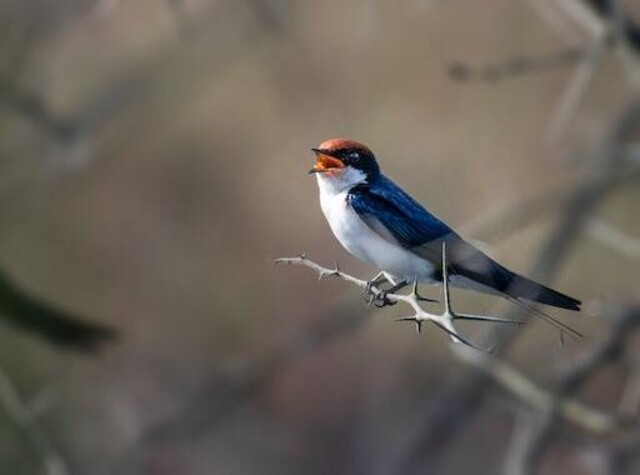
Planting Swallow-Friendly Vegetation
One great way to make your yard more welcoming for swallows is by planting vegetation that they will love.
Swallows are attracted to areas with plenty of insects, so planting native plants that attract a variety of insects will help attract these birds.
Some swallow-friendly vegetation options include flowering plants such as milkweed, butterfly bush, and bee balm, as well as grasses like switchgrass and little bluestem.
These plants not only provide a food source for swallows, but also offer nesting materials such as soft grasses and fibers.
Additionally, providing a mix of shrubs and trees can create a diverse habitat that swallows will find appealing.
Remember to avoid using pesticides, as they can harm both the insects and the swallows that rely on them for food.
Plant lots of these flowers because birds love colorful blooms for eating nectar.
| Plant Trees | Plant Flowers | Swallow Types Attracted |
|---|---|---|
| Catalpa | Red Roses | Tree Swallows, Violet-green Swallows |
| Sycamore | Hydrangeas | Tree Swallows |
| Tulip | Tulips | Tree Swallows |
| Poplar | Lilies | Barn Swallows, Cliff Swallows |
| Yellowwood | Joe Pye Weed | Tree Swallows, Violet-green Swallows |
| Ficus | Queen Anne’s Lace | Tree Swallows, Violet-green Swallows |
| Oak | Goldenrod | Tree Swallows, Violet-green Swallows |
| Alder | Boneset | Tree Swallows, Violet-green Swallows |
| White-barked Tamarisk | Purple Loosestrife | Barn Swallows, Cliff Swallows |
| Hickory | Zinnias | Tree Swallows, Violet-green Swallows |
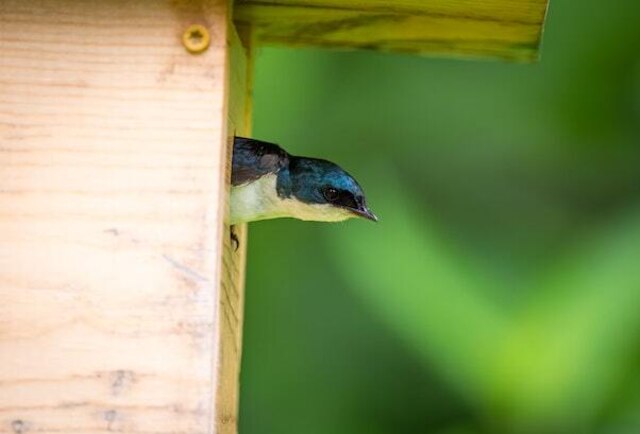
Maintaining a Safe and Welcoming Yard
Make sure you keep your yard free from harmful chemicals and create a safe environment for the swallows to thrive in.
Chemicals such as pesticides and herbicides can be toxic to swallows, so it’s important to avoid using them in your yard.
Instead, opt for natural pest control methods like attracting beneficial insects and birds that can help keep pest populations in check.
Additionally, avoid using synthetic fertilizers, as they can contaminate the water sources that swallows rely on for drinking and bathing.
Create a welcoming habitat by providing nesting boxes or platforms for the swallows to build their nests. These structures should be placed in a safe location, away from potential predators.
Lastly, keep your yard clean and free from clutter to prevent any hazards or obstacles that may harm the swallows.
By following these guidelines, you can maintain a safe and inviting yard that will attract swallows and provide them with a suitable environment to thrive in.
Conclusion
In conclusion, attracting swallows to your yard is an achievable and rewarding endeavor.
By creating a welcoming habitat, offering a diverse menu of insects, maintaining a clean environment, and incorporating water features, you can entice these graceful birds to call your yard home.
Additionally, planting the right trees and flowers can further enhance their attraction.
Remember, with a little effort and the right resources, your yard can become a haven for swallows.
So, get ready to embrace the joy of bird-watching and witness the beauty of swallows soaring through your own backyard.
Frequently Asked Questions
What month do Swallows lay their eggs?
In some regions of the world, swallows return in the spring to lay their eggs. For example, many Northern Hemisphere countries will see birds returning as early as March or April. This is because they want to get a head start on raising their young before winter hits.
Which direction should a bird house face?
If you want to attract the most swallows, then your entrance hole should be away from direct winds and be facing northeast. This way, the morning sun will shine into the house before any other house in your area.
How high off the ground should a bird house be?
A good rule of thumb is to build your swallow bird house approximately 8-12 feet off the ground. This is high enough to keep predators from reaching it but low enough that humans can still reach it with ease.
Do Swallows return to the same place every year?
Yes, every year when winter is over, swallows actually return to the same spot where they nested last year because it provides them with everything they need: food, shelter, and safety.
Can Swallows eat bird seed?
Swallows mostly feed on insects during the summer months, but when food becomes scarce or difficult to find in winter, they will resort to eating seeds and berries as well.
Why do Barn Swallows dive at you?
Barn swallows are known for their habit of dive-bombing people, especially those who have made a nest on the barn. This is not an attack, as they do not actually hit humans with their wings; rather, it is to scare them away from their nests.

